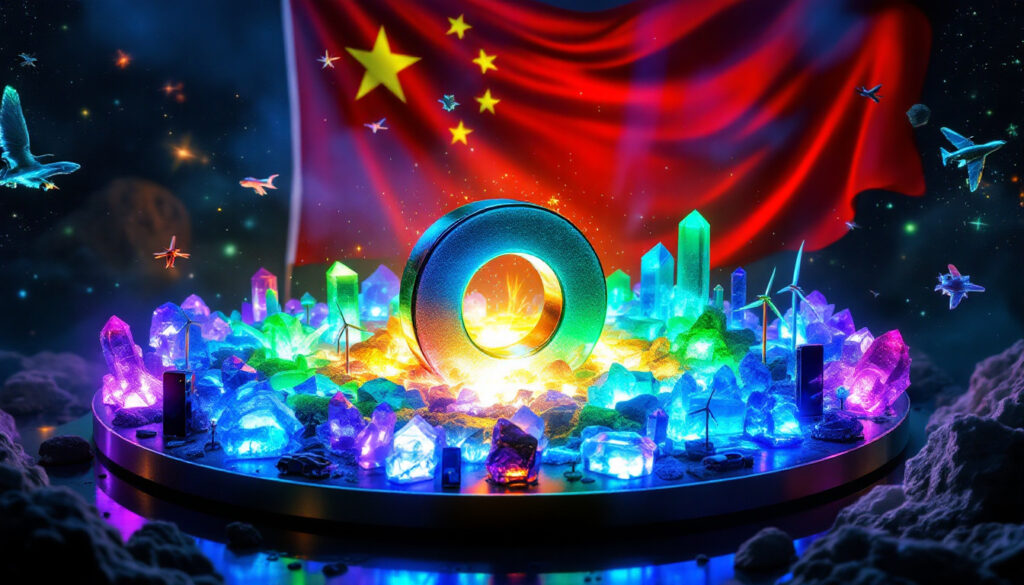What Are Rare Earth Elements and Why Do They Matter?
The Invisible Metals Powering Modern Technology
Rare earth elements permeate modern life despite remaining relatively unknown to the general public. These 17 specialized metals form the backbone of countless technologies we rely on daily – from smartphones and electric vehicles to military hardware and renewable energy systems.
Yttrium, one of these critical elements, exemplifies their versatility. This lesser-known metal enables jet engines to withstand extreme temperatures, enhances microwave radar performance, powers superconductors, and even finds applications in modern dentistry. Despite this importance, global production remains remarkably limited – the U.S. Geological Survey estimates worldwide yttrium production at merely 20,000 metric tons annually.
China recently escalated tensions by adding seven rare earth elements to its dual-use export restriction list: dysprosium, terbium, samarium, yttrium, praseodymium, neodymium, and cerium. While these names might sound obscure, their applications are anything but – they're essential components in technologies that define modern civilization.
What makes these elements truly remarkable is how little material is required for critical applications. Just a few grams of dysprosium can dramatically improve the performance of magnets operating at high temperatures, while trace amounts of terbium enable vibrant display screens in consumer electronics.
The Critical Role of Rare Earth Magnets
Permanent magnets made with rare earth elements quite literally "make the modern world go round." These powerful magnetic materials enable the miniaturization and performance enhancement of countless electrical systems we depend on daily.
Dysprosium and terbium serve as crucial additives that enhance neodymium magnets' performance, allowing them to maintain magnetic properties at high temperatures – a critical requirement for electric vehicle motors, wind turbines, and military hardware. Without these enhancements, magnets would lose their magnetic properties at temperatures commonly reached during operation.
Samarium, when combined with cobalt, creates exceptionally powerful magnets that excel in specialized applications. These samarium-cobalt magnets maintain their magnetic properties across extreme temperature ranges, making them irreplaceable in missile guidance systems and fighter aircraft avionics where reliability is non-negotiable.
The rare earth magnet supply chain presents a particular vulnerability for Western economies. According to research from CRU Group, China supplies approximately 90% of the world's rare earth magnets, giving Beijing unprecedented leverage over industries ranging from consumer electronics to defense. A single Tesla Model 3 electric vehicle contains roughly 1.2 kg of rare earth materials in its permanent magnet motor – all sourced from a supply chain dominated by Chinese interests.
How Is China Weaponizing Rare Earths?
China's Escalating Export Restrictions
Beijing has methodically increased pressure on Western supply chains by progressively restricting exports of critical minerals. The recent addition of seven rare earth elements to its dual-use export control list represents the latest escalation in this strategy, following earlier restrictions on antimony, gallium, and germanium.
The dual-use watch list designation allows Chinese authorities unprecedented scrutiny over buyers. Companies must now apply for licenses specifying end-users and applications, enabling China to effectively exclude those connected to military supply chains. This selective approval system offers Beijing significant flexibility – allowing civilian applications to continue while choking off defense-related supply lines.
The gradual nature of China's rare earth export controls follows a consistent pattern. Chinese exports of germanium and gallium to the United States effectively stopped months before the December 2024 full ban was implemented. This progressive tightening allows China to gauge Western responses and adjust tactics accordingly while minimizing immediate WTO challenges.
Industry analysts note that these controls operate through a sophisticated "graded licensing" framework where civilian applications might face a 45-day approval process, defense contractors experience automatic license rejection, and third-country intermediaries encounter enhanced customs inspections with shipment delays exceeding 35%.
The Market Impact of Export Controls
The economic consequences of China's rare earth export restrictions have been immediate and severe across multiple mineral markets. Antimony, essential for fire retardants and batteries, saw prices surge from $14,000 to nearly $60,000 per ton following China's decision to cut exports to the United States – a 324% increase that forced battery manufacturers to redesign anode chemistries at estimated R&D costs exceeding $120 million per company.
Bismuth presents another cautionary tale. After being placed on the dual-use list in February, prices jumped dramatically from $6 to $40 per kilogram, disrupting pharmaceutical and metallurgical supply chains worldwide.
These recent actions echo China's 2010 rare earth export restrictions targeting Japan during a territorial dispute. That incident triggered price spikes where dysprosium oxide surged from $147/kg to $3,830/kg within eight months. Though China ultimately lost a World Trade Organization case regarding those restrictions, the ruling came too late to prevent significant economic damage and market restructuring that cemented China's dominance.
Current market data shows comparable rare earth market volatility emerging in rare earth prices, with terbium reaching $4,540/kg (up 62% quarterly since Q1 2025), samarium climbing to $41/kg, and yttrium hitting $88/kg. These price increases translate directly to production cost increases across multiple sectors – EV motor costs rising 18-22%, wind turbine drive systems up 15%, and precision-guided munitions increasing by 32%.
Why Does China Dominate the Rare Earth Market?
China's Grip on the Global Supply Chain
China's rare earth hegemony extends far beyond mining alone, encompassing every stage of the value chain. While accounting for approximately 60% of global mining production, China's true leverage comes from controlling around 90% of processing capacity – the complex metallurgical operations that transform raw ore into usable materials.
The Bayan Obo complex alone accounts for 45% of global rare earth output, employing proprietary solvent extraction techniques that achieve 99.9999% purity levels. This technical expertise proves difficult to replicate, with China maintaining 78 patents on closed-loop recycling systems essential for environmentally responsible processing.
China's influence extends to neighboring countries as well. Myanmar, the world's second-largest producer of heavy rare earths, maintains close economic ties with China, with significant Chinese equity stakes in key mining operations. These operations account for 38% of global rare earth reserves, further extending Beijing's effective control.
The dependence of Western supply chains becomes apparent when examining the Mountain Pass mine in California – the only major U.S. rare earth operation. Despite producing approximately 15% of global rare earth oxides, Mountain Pass sends its entire output to China for separation and refining due to the absence of domestic chloride leaching capacity.
Limited Production Outside China
The challenge for Western countries extends beyond simply opening new mines. Serra Verde in Brazil represents the only significant producer of heavy rare earths outside China, Myanmar, and Laos. However, even this operation sends its material to China for processing, highlighting the deep integration of global supply chains with Chinese technical infrastructure.
Multiple barriers prevent Western companies from establishing competitive alternatives:
Technical challenges arise from rare earth separation processes requiring specialized handling of hydrofluoric acid at industrial scale. Chinese production costs average 40% below Western equivalents due to state-subsidized energy ($0.03/kWh versus $0.12/kWh U.S. industrial rates). Regulatory hurdles further complicate Western efforts, with U.S. mine permitting timelines averaging 7-10 years compared to just 2 years in China.
Lynas Corporation's Malaysian plant stands as the sole operational Western separation facility, yet it operates at only 65% capacity due to thorium disposal restrictions. This facility produces just 6% of global dysprosium output – insufficient to meet Western demand.
Western countries have largely failed to develop significant alternative supply chains since the 2010 warning provided by China's actions against Japan. China's rare earth giants benefit from economies of scale, technical expertise, and government support that make competition extremely difficult for new entrants without sustained government intervention.
What Are Western Countries Doing to Reduce Dependence?
Western Response to Supply Chain Vulnerability
Multiple projects to increase production capacity outside China are underway in the United States and Europe, but progress remains slow and fragmented. The U.S. Department of Energy's Advanced Manufacturing Office has allocated $2.7 billion across 14 rare earth projects since 2022, yielding mixed results.
MP Materials' Mountain Pass expansion has received $35 million in federal funding and successfully launched Phase 1 operations, with projected output of 5,000 tons of rare earth oxides by 2025. However, other initiatives show less progress – the BlueOval Magnet project has reached only pilot production levels despite $117 million in funding, while ReElement Technologies remains at lab-scale separation despite $22 million in government support.
Recycling initiatives demonstrate greater near-term potential, with U.S. startups like Noveon achieving 92% recovery rates from end-of-life magnets. However, collection infrastructure remains inadequate – less than 1% of rare earths are currently recycled compared to 40% of lithium-ion battery materials.
USA Rare Earth CEO has stated bluntly that "America's dependence on China is unsustainable," highlighting the strategic vulnerability created by decades of supply chain offshoring. Despite this recognition and increasing investment, few projects are near commercial production or can compete with China's established economies of scale without sustained government support.
The Countdown to Supply Disruption
The immediate impacts of China's export controls are already emerging. Export restrictions cause short-term supply disruptions as exporters scramble to apply for new licenses under the dual-use designation. Industry sources report 6-9 month delays in magnet shipments to NATO-aligned countries and 45% increases in defense contractor contingency sourcing costs.
Chinese authorities have demonstrated their willingness to block sales to Western buyers involved in military procurement chains. Historical patterns suggest targeted actions rather than comprehensive bans, allowing China to maintain market position while exerting maximum pressure on strategic sectors.
A full rare earth export ban likely remains in reserve as an escalation option as the critical minerals race between China and the United States continues to intensify. The U.S. Defense Logistics Agency's stockpile contains just three months of terbium supply at current consumption rates, with replenishment costs up 400% since 2023.
Industry experts warn that the "rare earth time bomb is now ticking," with immediate price shocks, medium-term supply gaps, and long-term innovation barriers demanding coordinated international response mechanisms beyond current bilateral agreements.
China's Strategic Leveraging of Critical Mineral Dominance
China's approach to rare earth export restrictions represents a sophisticated economic strategy that combines market leverage with geopolitical objectives. Unlike crude embargoes, Beijing's tiered approach to export controls allows selective pressure on strategic industries while maintaining commercial relationships with civilian sectors.
The effectiveness of this strategy stems from China's comprehensive dominance across the entire rare earth value chain – from mining (60% of global production) to processing (92% of separation capacity) to manufacturing (87 of 98 operational magnet plants globally). This vertical integration creates multiple chokepoints that Western nations must address simultaneously to achieve meaningful supply security.
Western responses have largely focused on mining capacity, neglecting the equally critical processing and manufacturing stages. While new mines may reduce dependence on Chinese raw materials, the absence of competitive separation facilities ensures continued reliance on Chinese technical infrastructure for the foreseeable future.
Market signals indicate that prices have not yet reached levels necessary to stimulate sufficient private investment in Western processing capacity. Without coordinated government intervention to reduce regulatory barriers and provide long-term demand certainty, market forces alone appear insufficient to overcome China's established advantages in scale, expertise, and cost structure.
Pathways to Reducing Western Vulnerability
Developing Resilient Supply Chains
Creating genuine alternatives to Chinese rare earth supply chains requires a multifaceted approach addressing all stages of production. Strategic priorities for Western countries should include:
Accelerating permitting processes for environmentally responsible mining operations while maintaining essential environmental protections. Current timelines of 7-10 years for new mines prove incompatible with the urgent need for supply diversification.
Establishing public-private partnerships to develop processing facilities capable of handling both light and heavy rare earths. The technical complexity and capital intensity of these operations make pure private sector solutions unlikely in competitive timeframes.
Expanding recycling infrastructure with standardized collection systems and incentives for recovering materials from end-of-life products. Current recovery rates below 1% represent a significant missed opportunity for reducing primary material requirements.
Technological Alternatives and Material Substitution
Research into reduced rare earth content and alternative materials offers another pathway to decreasing dependency. Recent innovations in this area include:
Motor designs that reduce dysprosium requirements by 30-40% through improved thermal management systems that prevent demagnetization at high temperatures. These designs maintain performance while dramatically reducing exposure to supply disruptions.
Alternative magnet chemistries using more accessible materials like iron nitride, which achieves 76% of neodymium magnet performance while eliminating rare earth content entirely. Though not yet commercially competitive, these technologies show promise for applications with less stringent performance requirements.
For the most critical applications, particularly in defense, stockpiling represents an essential near-term strategy. Expanding strategic reserves to cover 12-18 months of consumption would provide security during the transition to more diversified supply chains. Meanwhile, efforts towards boosting global rare earth supply continue in countries like Australia.
FAQ About China's Rare Earth Export Restrictions
What exactly are rare earth elements?
Rare earth elements comprise a group of 17 metals that, despite their name, are relatively abundant in the Earth's crust but rarely found in concentrated deposits. They include elements such as yttrium, dysprosium, terbium, and samarium, which are crucial for manufacturing high-performance magnets and numerous high-tech applications. The term "rare" refers more to the difficulty of extraction and separation than to actual scarcity in the Earth's crust.
Why is China's dominance of rare earths concerning?
China controls approximately 60% of global rare earth mining and 90% of processing capacity, giving it significant leverage over global supply chains. This dominance allows China to potentially disrupt industries ranging from consumer electronics to defense by restricting exports, as demonstrated by recent additions to its dual-use export control list. The concentration of expertise and infrastructure creates a strategic vulnerability for Western economies increasingly dependent on technologies requiring these materials.
How might these restrictions impact global markets?
Based on previous restrictions, prices could surge dramatically – antimony jumped from $14,000 to nearly $60,000 per ton after China restricted exports to the US. Similar price spikes could occur for rare earth elements, causing significant disruption to manufacturing supply chains globally. These price increases translate directly to higher production costs across multiple industries, potentially accelerating inflation in technology sectors while delaying clean energy transitions reliant on these materials.
What industries are most vulnerable to rare earth supply disruptions?
Industries most at risk include electric vehicles, wind turbines, consumer electronics, and defense manufacturing. These sectors rely heavily on rare earth magnets and other components that currently have limited production outside of China's sphere of influence. The defense sector faces particular vulnerability due to the stringent performance requirements for materials used in advanced weapons systems, where substitutes often provide inadequate performance characteristics.
Ready to Spot the Next Major Mineral Discovery?
Discover why major mineral discoveries like rare earth elements can lead to substantial market returns by exploring Discovery Alert's dedicated discoveries page, where our proprietary Discovery IQ model delivers real-time alerts on significant ASX mineral discoveries, instantly transforming complex data into actionable investment insights.




